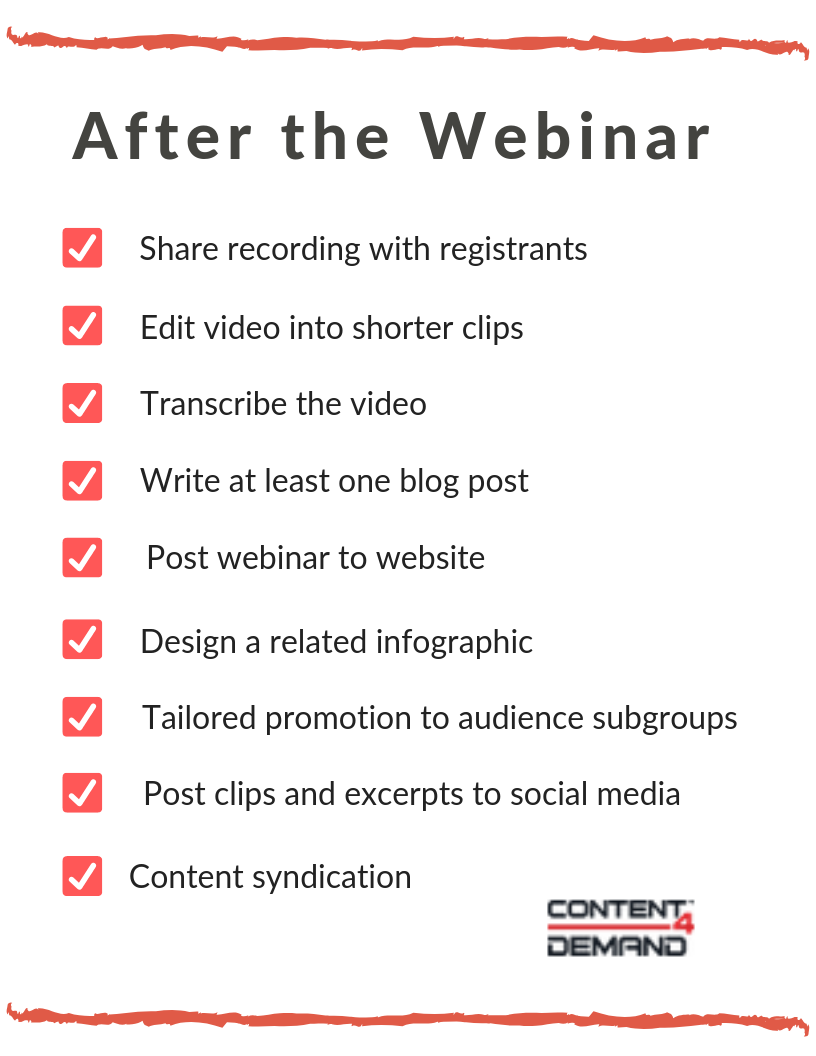If webinars are part of your marketing strategy, you know how much work goes into planning and executing them. Are you sure you’re doing all you can to leverage that content to get the greatest ROI for your efforts and extend their value for as long as you can? Webinars – particularly those with evergreen content – can become a steady stream of derivative content that continues to attract attention to your brand.
Webinars create the opportunity to generate high-quality leads. In fact, 63% of respondents in the Content Preferences Survey Report said they were willing to spend 20 to 60 minutes watching a webinar, and 50% name them as a top format they share with colleagues. Webinars connect your prospects with your brand in a much more intimate way than a white paper or an infographic ever could.
Here are some tips to keep the webinar love alive long after they’ve aired.
Before the Webinar
When you first get started, consider whether your title and topic are unnecessarily dating the content. Rather than presenting your round-up of the latest industry trends as “Top Martech Trends of 2020,” calling it “Must-Know Best Practices in Today’s Martech World” or “The Future of Martech” means your content won’t immediately appear dated when a prospect stumbles across it in 2021. Dig deeper than the title to see if you’re framing any of the topics in a way that will make it seem outdated more quickly.
Use your best-performing assets to inspire your webinars. If you have a blog post or another evergreen asset that has continued to perform well for more than a year, update and refresh it, and turn it into a webinar. You’ll have a basic content outline already in place and can focus on adding the “wow” factor to deliver an engaging presentation.
Think about how you can engage your audience during the webinar in ways that can fuel your follow-up efforts. Turn a live question-and-answer session into a follow-up brief or checklist you can share afterward.
After the Webinar
What, you thought you were done? You’re leaving so much opportunity on the table if you let your webinar sit idle in the deepest recesses of your website.
The first thing you should be doing is to share the recorded webinar with everyone who registered. Then add it to the resources page on your website.
Transcribe the presentation to create a blog post, and consider whether to include it in your content syndication efforts. Adding the transcript alongside the webinar on your website is a great way to improve SEO, and it makes it easier for “cut to the chase” viewers to find the portions they’re interested in.
There should be an abundance of ideas and webinar segments that you can quickly transform into additional assets: social media posts, blog posts, checklists – just about anything you need. Design an infographic around the coolest insights or most compelling data points from the webinar. Challenge yourself to see how many ways you can leverage your webinar into follow-on assets.
We’ve all bailed out on webinars we’ve found interesting just because we didn’t have the time or didn’t want to sit through portions that were less relevant to us. Cater to this audience by slicing the full webinar into smaller video clips with quick, hard-hitting takeaways that you can promote in email nurtures or via social media. Think about including some of these clips on your blog as well.
When it comes to promoting the webinar, don’t neglect the countless people who didn’t register the first time. Examine your lists for subgroups for whom you can tweak the messaging to better appeal to their specific interests with some email outreach, whether you do that through vertical targeting, topical interests or any other factors.

Bask in Your Success
When you take a strategic approach to each webinar you produce, you can make sure it generates plenty of additional content and achievea greater ROI for all that work you invested to make it go live. Here’s a handy checklist to help you incorporate these tips.
Before you roll up your sleeves to polish up your webinar marketing strategies, check out our previous post, “How to Fine-Tune Your Data Strategies with Webinars.”



